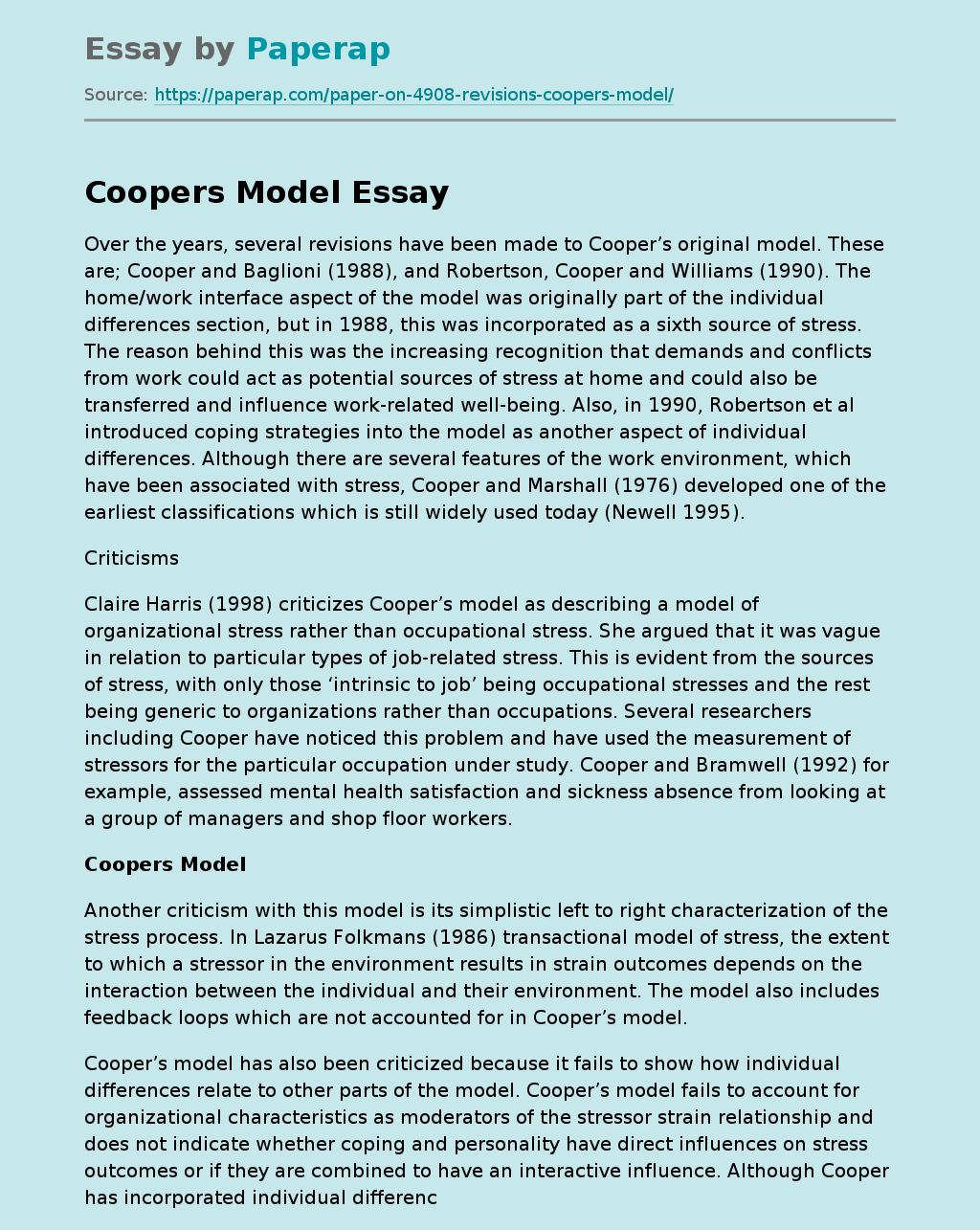Coping Strategies in Cooper's Model
The following sample essay on Coopers Model tells about coping strategies into the model.
Over the years, several revisions have been made to Cooper’s original model. These are; Cooper and Baglioni (1988), and Robertson, Cooper and Williams (1990). The home/work interface aspect of the model was originally part of the individual differences section, but in 1988, this was incorporated as a sixth source of stress. The reason behind this was the increasing recognition that demands and conflicts from work could act as potential sources of stress at home and could also be transferred and influence work-related well-being.
Also, in 1990, Robertson et al introduced coping strategies into the model as another aspect of individual differences. Although there are several features of the work environment, which have been associated with stress, Cooper and Marshall (1976) developed one of the earliest classifications which is still widely used today (Newell 1995).
Criticisms
Claire Harris (1998) criticizes Cooper’s model as describing a model of organizational stress rather than occupational stress.
She argued that it was vague in relation to particular types of job-related stress. This is evident from the sources of stress, with only those ‘intrinsic to job’ being occupational stresses and the rest being generic to organizations rather than occupations. Several researchers including Cooper have noticed this problem and have used the measurement of stressors for the particular occupation under study. Cooper and Bramwell (1992) for example, assessed mental health satisfaction and sickness absence from looking at a group of managers and shop floor workers.
Another criticism with this model is its simplistic left to right characterization of the stress process.
In Lazarus Folkmans (1986) transactional model of stress, the extent to which a stressor in the environment results in strain outcomes depends on the interaction between the individual and their environment. The model also includes feedback loops which are not accounted for in Cooper’s model.
Cooper’s model has also been criticized because it fails to show how individual differences relate to other parts of the model. Cooper’s model fails to account for organizational characteristics as moderators of the stressor strain relationship and does not indicate whether coping and personality have direct influences on stress outcomes or if they are combined to have an interactive influence. Although Cooper has incorporated individual differences in the model, further evidence is required to establish whether or not these differences have a direct effect or moderate strain outcomes. In addition to these criticisms, Cooper’s model does not account for other well known researched individual differences such as neuroticism (relating to well-being) and less researched factors such as extroversion and competence (Warr 1987).
Cooper’s 1986 model of work-related stress describes the main features of an individual’s work and also of his/her home environment. He describes these in the ‘Model of Stress at Work.’ Although Cooper’s model is simplistic, it does give a general overview of how stress can influence an individual’s relationships at work and at home. It could be argued that Cooper’s model only concentrates on organizational stressors i.e. organizational structure, relationships at work, or career development. That being said, he mentions the feature of ‘intrinsic to job’, which is in fact related to occupational stress.
Cooper’s model is still widely use today in the field of occupational psychology, but further revisions need to be made which describe the individuals coping strategies and personality, as they play a major role in the workplace with regards to a persons health. Further research also needs to be conducted on existing data and then it needs to be analysed directly with the H.S.E.
Coping Strategies in Cooper's Model. (2019, Dec 05). Retrieved from https://paperap.com/paper-on-4908-revisions-coopers-model/

